A 6 day split is a training approach where you perform six weekly training sessions and only rest for one day. The high-frequency program offers numerous benefits and works well for trainees looking to build strength and muscle more quickly. But, given its demanding nature, a 6 day split comes with some drawbacks, and anyone interested in working out six times per week needs to be aware of the potential problems.
One notable benefit of a 6 day split is that you can organize your training in multiple ways, including through the principles of a push/pull/legs routine. Having more frequent workouts allows you to spread your weekly training volume more evenly, resulting in shorter and less demanding sessions.
Unfortunately, working out six days each week might not be sustainable for most people, especially those with a busy schedule or people new to weight training. Such individuals might benefit from a less demanding approach, like a 4-day split.
What are the Benefits of the 6 Day Split?
A notable benefit of the 6 day split is that you can train all major muscle groups the recommended two times per week (1). Regardless of your approach, working out six times provides plenty of opportunities to stimulate your muscles adequately and promote growth.
Another benefit of the approach is that you can do plenty of exercises and sets without spending that much time in the gym during each session. For example, people interested in doing more volume for their chest muscles (say, 20 sets per week) can split that work across two sessions and finish quicker. The same applies to all muscle groups because more workouts mean you can do more sets and promote better muscle growth. Keep track of your sets and progress with the Hevy Workout Tracker.
Hevy Workout Tracker
Create your own workout splits with Hevy, and track your progress. Join +2M athletes.

For Personal Trainers
Personal trainer software to build workout programs for your clients, and track their progress.
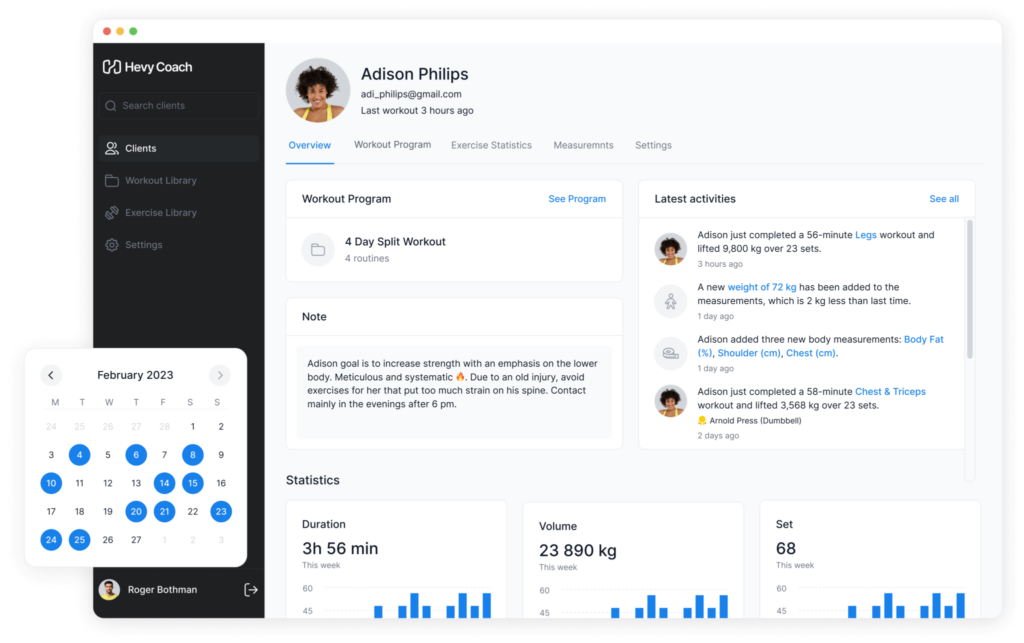


Similarly, having six weekly workouts means each one is less demanding. For instance, people who cannot commit to more than three weekly workouts have to do more sets and exercises per session, leading to more fatigue and significant muscle soreness. In contrast, people training six days per week accumulate enough volume within 40 to 60 minutes, experience smaller drops in performance, and keep soreness at bay.
The third notable advantage of a 6 day split is that it works great for strength gains. You have more opportunities to train the primary lifts (bench press, squat, etc.), and you don’t have to push yourself as hard during each session (2). As a result, you maintain your performance across all sets, get quality practice done, and are less likely to become overtrained or experience technique breakdown due to fatigue. You can include some assistance and isolation work alongside the primary compound lifts and stimulate hypertrophy while improving your strength numbers.
Is the 6 Day Split An Effective Workout?
A 6 day split can be effective if you understand how to set it up correctly. For one, it’s easy to train all major muscle groups two to three times per week. Second, you can accumulate the necessary training volume for optimal growth without spending over an hour at the gym each time (3).
The third notable benefit is that each workout is less demanding, and you don’t feel as tired when you’re done. You also experience less significant muscle soreness because you’re training your muscles more frequently.
On top of that, working out six times per week means you can practice the core lifts (squats, bench press, deadlift, etc.) more frequently, leading to quicker and more predictable strength gains (2). For instance, you can perform the squat, bench press, and deadlift twice per week, starting each workout with one of the three movements. You can pair these core lifts with assistance and isolation work and finish in 40 to 45 minutes.
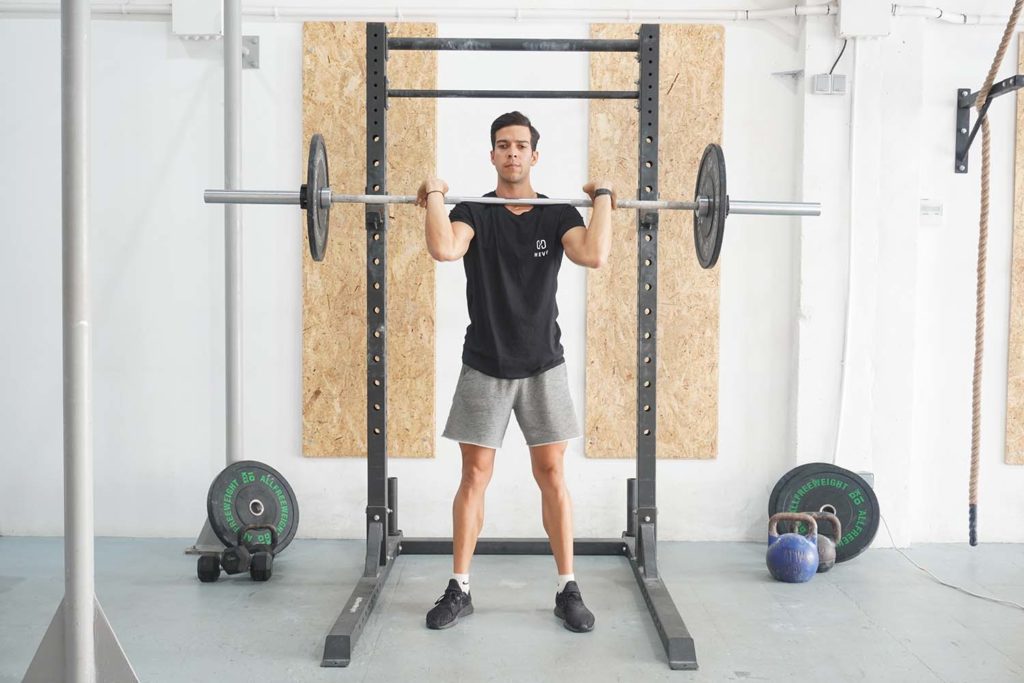

Many people wonder if a 6 day split would help them make quicker strength and muscle gains. To determine that, we have to answer a couple of questions:
1. Can you train six days every week?
You might be motivated to level up your training and make real progress but ask yourself if you can stick with six weekly workouts. Trainees often believe they can, but life obligations tend to get in the way and ruin our gym momentum.
2. How experienced are you?
Beginners are often eager to jump on a demanding training program and make fast gym progress. The problem is that six weekly workouts can be physically and mentally draining, especially for people unaccustomed to structured exercise. It would be best to start with a more moderate approach unless you have years of experience and have experimented with a 5-day split.
A 6 day split is most suited for younger people with enough free time and plenty of training experience. The 6 day approach is also best used during bulking periods, where you consume more calories than you burn, aiming to gain weight and increase your muscle mass. Hitting the gym six times while dieting to lose fat will quickly lead to recovery issues. Plus, you don’t need that much training volume to maintain your muscle, and a simple upper/lower split might work better then.
Is it Okay to Workout 6 Days a Week?
While most people focus solely on the training side of the equation, proper recovery is equally as crucial for muscle growth. Training stresses your muscles, joints, bones, connective tissues, and central nervous system, causing you to leave the gym in a weaker and more compromised state. But, given the time to recover, your body adapts to the stress by getting stronger.
The most practical way to ensure better recovery is to introduce rest days between workouts. For instance, when following the 5×5 program, you train three times per week and have four recovery days. Doing so allows you to cause a growth stimulus and gives you ample time to repair muscle damage and adapt, leading to steady progress.
An issue with 6 day splits is that you only have one recovery day for every six workouts, making you more likely to run into recovery issues.
As discussed in the previous point, a 6 day split would best suit young people with enough free time and plenty of training experience. Folks doing such a demanding split should also maintain a calorie surplus to support growth and recovery (4).
Another helpful tactic for limiting fatigue and reducing the risk of overtraining is keeping your workouts shorter. Even if you hit the gym daily, you won’t get as tired, and sticking with workouts won’t feel that demanding. For instance, if your workouts last around 75 minutes when training four times per week, you can add it up and divide by six to determine how long they should be on a 6 day split.
75 * 4 = 300 minutes (five hours)
300 minutes / 6 = 50 minutes per session on a 6 day split
You would be working out more frequently but keeping your overall training length the same.
Essential for Proper Recovery:


- Calorie surplus: eat more calories than you burn, aiming for steady weight gain each month. Doing so is essential for providing your body with the energy it needs for optimal recovery (4).
- Protein intake: consume 0.7 to 1 grams of protein per pound of body weight (5). The nutrient supplies your body with the building blocks (amino acids) it needs to repair muscle and develop individual muscle fibers.
- Sleep: get at least seven hours of sleep per night to promote muscle protein synthesis, maintain good health, and recover better after demanding workouts (6).
- Limit workout duration: avoid doing incredibly long workouts, especially when you first start doing a 6 day split. Keep workout length in check by following our instructions from above.
Workout recovery on a 6 day split can be tricky, and the approach is certainly not for everyone. Our tactics from above will put you in the best possible position for high-frequency training, good recovery, and steady progress.
6 Day Split: Pros and Cons
Now that we’ve covered some of the major points related to 6 day splits, it’s time to outline the most notable pros and cons you can expect. Read these to determine if a 6 day program would work or if you’d be better off with something else.
Pros
- You get to train all major muscle groups two to three times per week, depending on how you choose to schedule your sessions (1)
- The approach is excellent for strength gains because you can practice the core lifts two, three, or even four times per week (2)
- A 6 day split workout allows you to spread out your weekly sets, resulting in shorter and less demanding sessions
- Having six workouts ensures that you’re doing the optimal number of sets for optimizing muscle hypertrophy (3)
- You can schedule a 6 day split by leveraging the principles behind push/pull/legs, upper/lower, bro (body part) splits, and PHUL
- Following a 6 day split makes it easier to establish working out as a habit and something that’s part of your days
Cons
- Committing to six weekly workouts can turn into a considerable burden, and not everyone has the necessary discipline to hit the gym daily
- Working out six days per week might not be sustainable for people with busy schedules and those who often travel for work
- Training six times per week means you only get one recovery day, making you more likely to burn out or become overtrained
- Your programming must be perfect to ensure good recovery
- You’re more likely to get injured down the line simply because you’re placing more stress on your joints and connective tissues
- Peaking (gradually increasing intensity to ensure optimal performance on a specific day) and tapering (lowering training volumes before competitions) are more challenging to pull off when training six days per week
What to Consider when Choosing your Workout Plan?
Choosing the right workout plan can be challenging. You must consider many variables, take your lifestyle into account, and be honest about what you can sustain in the long run.


Considerations:
- Schedule. You must look at your life and determine what training program you can do. Many people would love to train five or six times per week, but working a job, raising children, traveling for work, and other obligations might get in the way.
- Fitness level. A beginner simply doesn’t need to train six days per week to make optimal progress. Intermediate-level trainees can also benefit from a lower-frequency approach. The only people who should consider a 6 day split are advanced and elite-level trainees.
- Life stress. Stress impacts your recovery, energy levels, and motivation. Adding too much extra tension in the form of a 6 day split can lead to burnout. Be honest and determine if you can handle the significant responsibility.
- Training goals. Do you want to lose some fat, build muscle, get stronger, or improve your fitness? A 6 day approach is useful for advanced people who want to make steady muscle and strength gains.
- Nutrition. Are you currently in a calorie surplus and gaining weight steadily? If not, do you plan on eating more while training six days per week?
- Recoverability. How would you rate your overall ability to recover from training? Can you honestly return to the gym day after day, or do you often need a day of recovery after a demanding training session?
There are many training approaches, and you don’t ‘have to’ follow a 6 day split if you think it isn’t for you. Other fantastic options include the 5×5 program, bro split, upper/lower, and push/pull/legs program.
6 Day Split workouts: Structures
Push Pull Legs Workout – 6 Day Split
A 6 day push/pull/legs split is one where you do each workout two times per week. Train your chest, shoulders, and triceps on push sessions, back and biceps on pull sessions, and all lower body muscles during legs.
Level: Advanced
| Day 1: Push | Day 2: Pull | Day 3: Legs |
| Bench Press (Dumbbell) 3 sets of 8 to 10 reps Arnold Press (Dumbbell) 3 sets of 10 to 12 reps Triceps Rope Pushdown 3 sets of 12 to 15 reps Lateral Raise (Dumbbell) 2-3 sets of 12 to 20 reps Butterfly (Pec Deck) 2-3 sets of 15 to 20 reps | Bent Over Row (Barbell) 3 sets of 8 to 10 reps Lat Pulldown (Cable) 3 sets of 10 to 15 reps Bicep Curl (Machine) 2-3 sets of 12 to 15 reps Face Pull 2-3 sets of 15 to 25 reps | Squat (Barbell) 3 sets of 6 to 10 reps Romanian Deadlift (Dumbbell) 3 sets of 8 to 12 reps Leg Extension (Machine) 3 sets of 12 to 20 reps Standing Calf Raise (Machine) 2-3 sets of 15 to 20 reps |
| Day 4: Push | Day 5: Pull | Day 6: Legs |
| Seated Overhead Press (Barbell) 3 sets of 8 to 10 reps Chest Dip 3 sets of 5 to 15 reps Skullcrusher (Dumbbell) 2-3 sets of 10 to 15 reps Front Raise (Cable) 2-3 sets of 12 to 20 reps | Inverted Row 3 sets of 5 to 15 reps Seated Cable Row 3 sets of 10 to 15 reps Dumbbell Row 2-3 sets of 10 to 15 reps Plate Curl 2-3 sets of 12 to 15 reps | Hip Thrust (Barbell) 3 sets of 6 to 10 reps Lunge (Dumbbell) 3 sets of 10 to 12 reps (per leg) Lying Leg Curl (Machine) 3 sets of 12 to 15 reps Seated Calf Raise 2-3 sets of 10 to 12 reps |
Modifications
Since you’re training six days per week, there isn’t anything you can change about your weekly schedule. One possible modification is to switch to an 8 day split, where you organize your training in blocks of eight days. Doing so would give you an extra day of recovery during the week, reducing the risk of overtraining or burning out. For example, if one block starts on Monday and ends on Tuesday the following week, you can do three workouts, take Thursday off, and resume. The only drawback is that your training schedule would change from week to week.
You can also adjust your exercise selection. For example, if doing Romanian deadlifts after squats feel too challenging, swap the movement for lying hamstring curls, glute bridges, or another less demanding activity.
The third modification relates to training intensity. Experiment with lighter and heavier weights on some movements to see what you enjoy and if certain changes lead to better progress, muscle activation, etc.
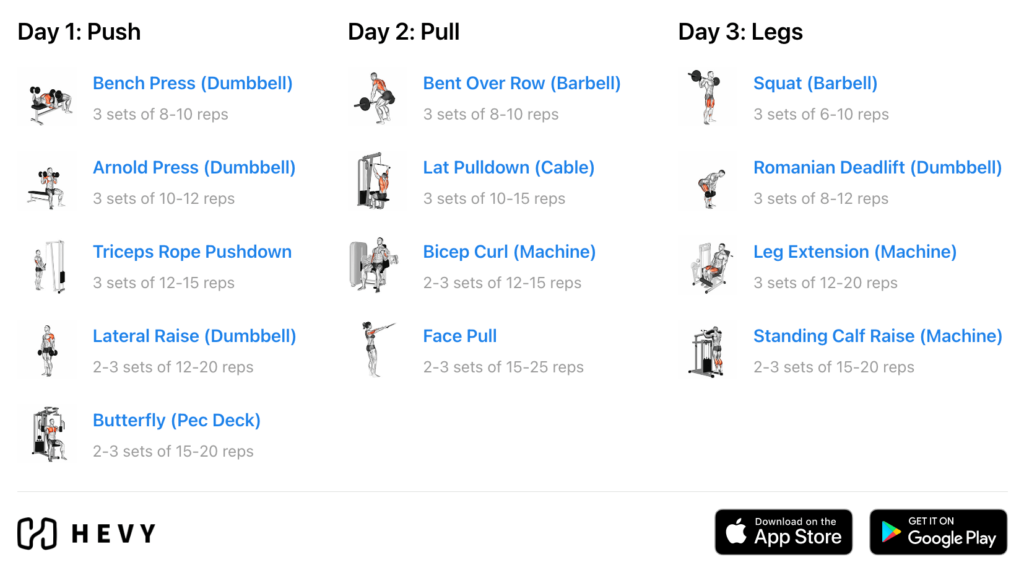

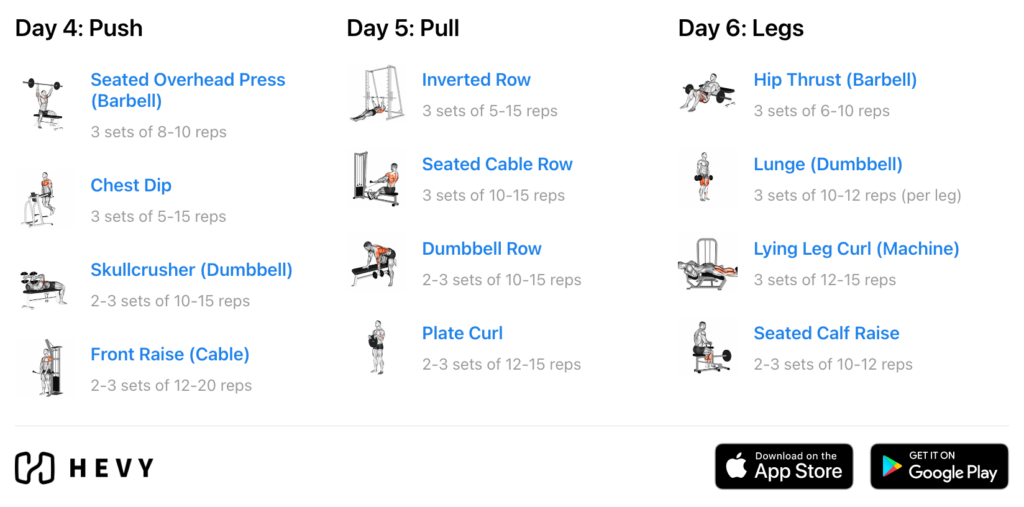

Schedule
Monday – Push
Tuesday – Pull
Wednesday – Legs
Thursday – Push
Friday – Pull
Saturday – Legs
Sunday – Off (Rest Day)
Arnold Schwarzenegger Workout Routines – 6 Day Split
The following is an advanced training split Arnold Schwarzenegger followed during his pro bodybuilding days.
Level: Advanced
| Day 1: Chest & Back | Day 2: Shoulders & Arms | Day 3: Legs & Lower Back |
| Bench Press 3-4 sets of up to 10 reps Incline Bench Press 3-4 sets of up to 10 reps Dumbbell Pullovers 3-4 sets of up to 10 reps Chin Up 3-4 sets of up to 10 reps Bent Over Row 3-4 sets of up to 10 reps Deadlift 3-4 sets of up to 10 reps Crunches 5 sets of up to 25 reps | Barbell Clean and Press 3-4 sets of up to 10 reps Dumbbell Lateral Raise 3-4 sets of up to 10 reps Upright Row 3-4 sets of up to 10 reps Military Press 3-4 sets of up to 10 reps Standing Barbell Curl 3-4 sets of up to 10 reps Seated Dumbbell Curl 3-4 sets of up to 10 reps Close Grip Bench Press 3-4 sets of up to 10 reps Standing Barbell Tricep Extension 3-4 sets of up to 10 reps Wrist Curls 3-4 sets of up to 10 reps Reverse Wrist Curls 3-4 sets of up to 10 reps Reverse Crunch 5 sets of up to 25 reps | Squat 3-4 sets of up to 10 reps Lunge 3-4 sets of up to 10 reps Leg Curl 3-4 sets of up to 10 reps Stiff Leg Deadlift 3-4 sets of up to 10 reps Good Mornings 3-4 sets of up to 10 reps Standing Calf Raise 3-4 sets of up to 10 reps Crunches 5 sets of up to 25 reps |
| Day 4: Chest and Back | Day 5: Shoulders and Arms | Day 6: Legs and Lower Back |
| Bench Press 3-4 sets of up to 10 reps Incline Bench Press 3-4 sets of up to 10 reps Dumbbell Pullovers 3-4 sets of up to 10 reps Chin Up 3-4 sets of up to 10 reps Bent Over Row 3-4 sets of up to 10 reps Deadlift 3-4 sets of up to 10 reps Crunches 5 sets of up to 25 reps | Barbell Clean and Press 3-4 sets of up to 10 reps Dumbbell Lateral Raise 3-4 sets of up to 10 reps Upright Row 3-4 sets of up to 10 reps Military Press 3-4 sets of up to 10 reps Standing Barbell Curl 3-4 sets of up to 10 reps Seated Dumbbell Curl 3-4 sets of up to 10 reps Close Grip Bench Press 3-4 sets of up to 10 reps Standing Barbell Tricep Extension 3-4 sets of up to 10 reps Wrist Curls 3-4 sets of up to 10 reps Reverse Wrist Curls 3-4 sets of up to 10 reps Reverse Crunch 5 sets of up to 25 reps | Squat 3-4 sets of up to 10 reps Lunge 3-4 sets of up to 10 reps Leg Curl 3-4 sets of up to 10 reps Stiff Leg Deadlift 3-4 sets of up to 10 reps Good Mornings 3-4 sets of up to 10 reps Standing Calf Raise 3-4 sets of up to 10 reps Crunches 5 sets of up to 25 reps |
Modifications
Arnold’s advanced split is incredibly demanding but also highly flexible. You can tweak almost everything about it, apart from the weekly training schedule. First, you can swap movements to fit your needs, abilities, and available equipment. For example, Arnold was a big fan of the wide-grip bench press, but you can do a narrow-grip or dumbbell press if a wider grip bothers your shoulders. Another example is chin-ups: a fantastic exercise for back growth. If you don’t have the strength, you can swap it for band-assisted chin-ups, pull-ups, or lat pulldowns.
It’s also good to start with fewer sets and exercises for all workouts. Arnold’s split has you training six days per week, which can get challenging if you’re not used to high-volume training. You can start with three to five movements per session and do no more than three to four sets per exercise.
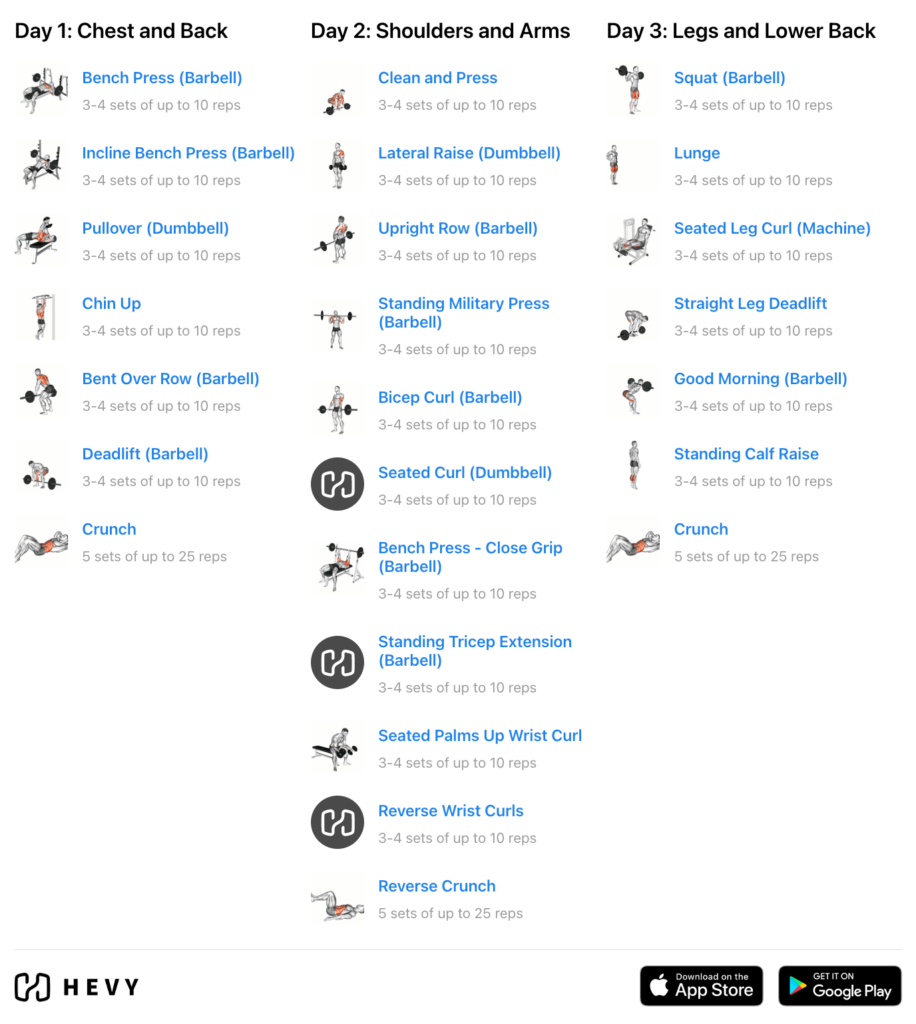

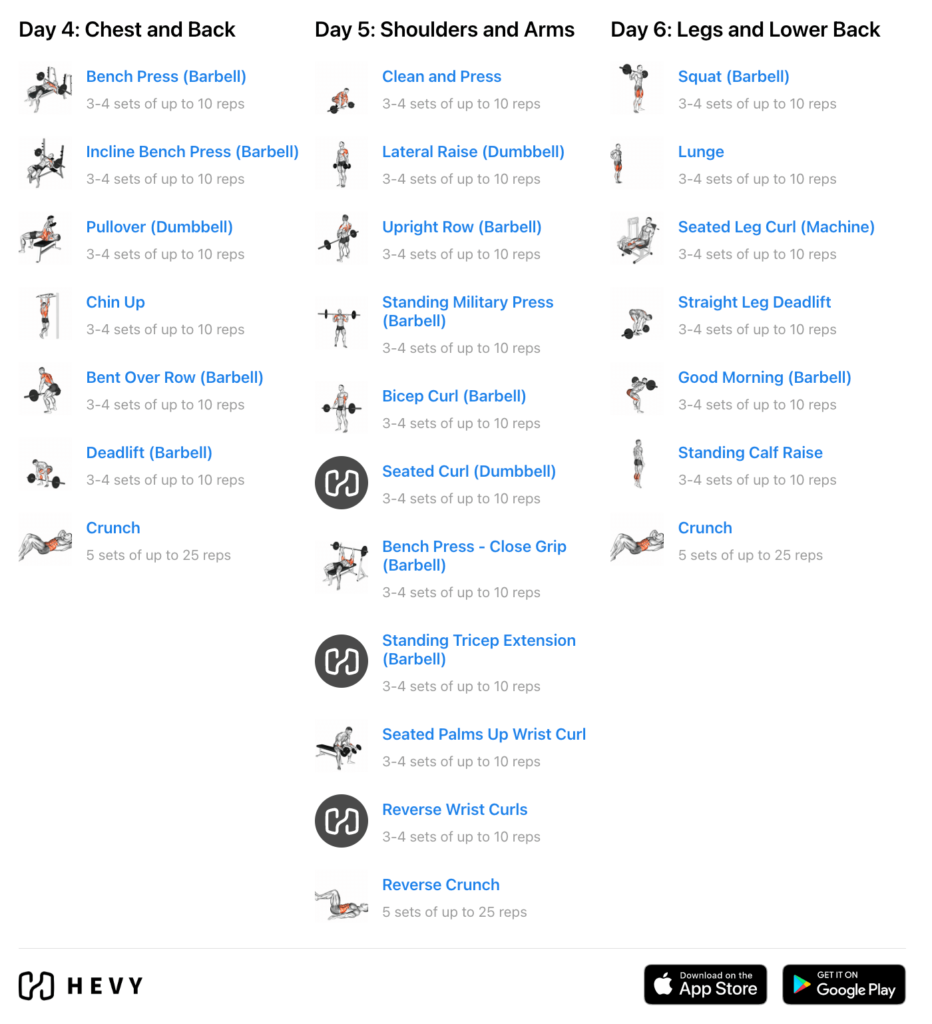

Schedule
Monday – Chest & Back
Tuesday – Shoulders & Arms
Wednesday – Legs &Lower Back
Thursday – Chest & Back
Friday – Shoulders & Arms
Saturday – Legs & Lower Back
Sunday – Off (Rest day)
Upper/Lower – 6 Day Split
A 6 day upper/lower split is one where you perform three upper and three lower-body workouts.
Level: Advanced
| Day 1: Upper | Day 2: Lower | Day 3: Upper |
| Bench Press (Dumbbell) 3 sets of 8 to 10 reps Seated Overhead Press (Barbell) 3 sets of 8 to 10 reps Inverted Row 3 sets of 5 to 15 reps Triceps Rope Pushdown 3 sets of 12 to 15 reps Lat Pulldown (Cable) 3 sets of 10 to 15 reps Plate Curl 2-3 sets of 12 to 15 reps | Squat (Barbell) 3 sets of 6 to 10 reps Romanian Deadlift (Dumbbell) 3 sets of 8 to 12 reps Standing Calf Raise (Machine) 2-3 sets of 15 to 20 reps | Arnold Press (Dumbbell) 3 sets of 10 to 12 reps Chest Dip 3 sets of 5 to 15 reps Seated Cable Row 3 sets of 10 to 15 reps Lateral Raise (Dumbbell) 2-3 sets of 12 to 20 reps Bicep Curl (Machine) 2-3 sets of 12 to 15 reps |
| Day 4: Lower | Day 5: Upper | Day 6: Lower |
| Hip Thrust (Barbell) 3 sets of 6 to 10 reps Leg Extension (Machine) 3 sets of 12 to 20 reps Glute Ham Raise 2-3 sets of 10 to 15 reps | Bent Over Row (Barbell) 3 sets of 8 to 10 reps Butterfly (Pec Deck) 2-3 sets of 15 to 20 reps Dumbbell Row 2-3 sets of 10 to 15 reps Skullcrusher (Dumbbell) 2-3 sets of 10 to 15 reps Front Raise (Cable) 2-3 sets of 12 to 20 reps Face Pull 2-3 sets of 15 to 25 reps | Lunge (Dumbbell) 3 sets of 10 to 12 reps (per leg) Lying Leg Curl (Machine) 3 sets of 12 to 15 reps Seated Calf Raise 2-3 sets of 10 to 12 reps |
Modifications
Modifying your weekly training schedule on a 6 day upper/lower split is impossible. Your only real option is to transition to an 8 day split, similar to how you could with the push/pull/legs split. Doing so would give you an extra recovery day, leading to better recovery. For instance:
Monday – Upper
Tuesday – Lower
Wednesday – Upper
Thursday – Lower
Friday – Off
Saturday – Upper
Sunday – Lower
Monday – Off
The above is an 8 day training block with two recovery days.
You can also modify your training volume and consider adding more work for your legs, especially if you struggle to gain strength or build mass. As you saw, Lower days have fewer movements than Upper workouts simply because there are fewer muscle groups to train. You can include more exercises for your quadriceps, hamstrings, calves, and glutes or do more sets. For example, we can modify the Day 2 Lower workout from:
Squat (Barbell)
3 sets of 6 to 10 reps
Romanian Deadlift (Dumbbell)
3 sets of 8 to 12 reps
Standing Calf Raise (Machine)
2-3 sets of 15 to 20 reps
To:
Squat (Barbell)
3 sets of 6 to 10 reps
Romanian Deadlift (Dumbbell)
3 sets of 8 to 12 reps
Bulgarian Split Squat
3 sets of 8 to 15 reps (per leg)
Standing Calf Raise (Machine)
2-3 sets of 15 to 20 reps
Or
Squat (Barbell)
4 sets of 6 to 10 reps
Romanian Deadlift (Dumbbell)
4 sets of 8 to 12 reps
Standing Calf Raise (Machine)
3-4 sets of 15 to 20 reps
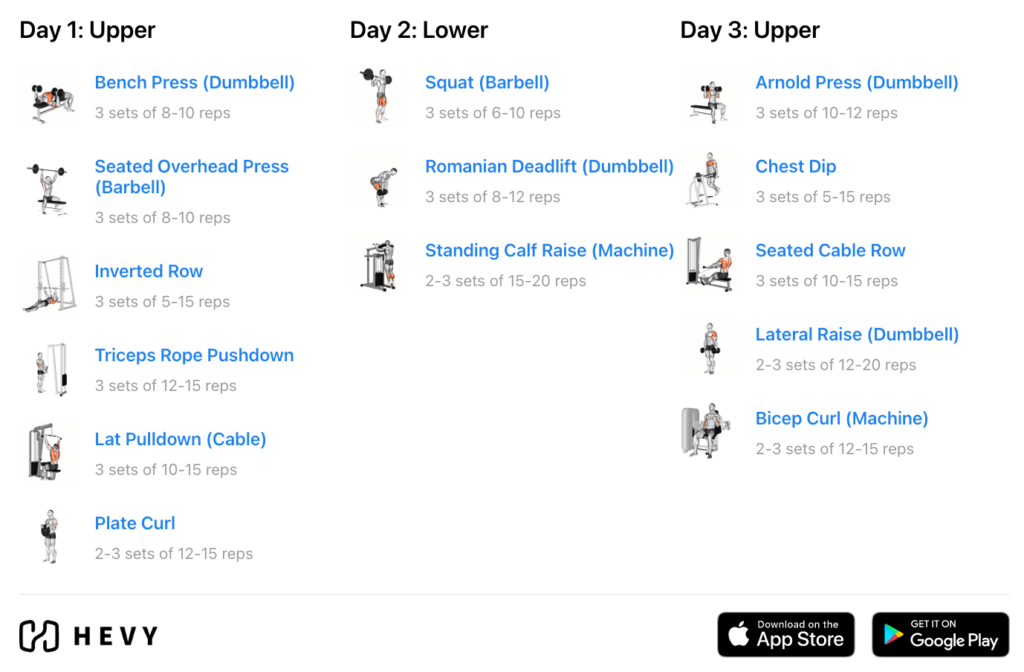

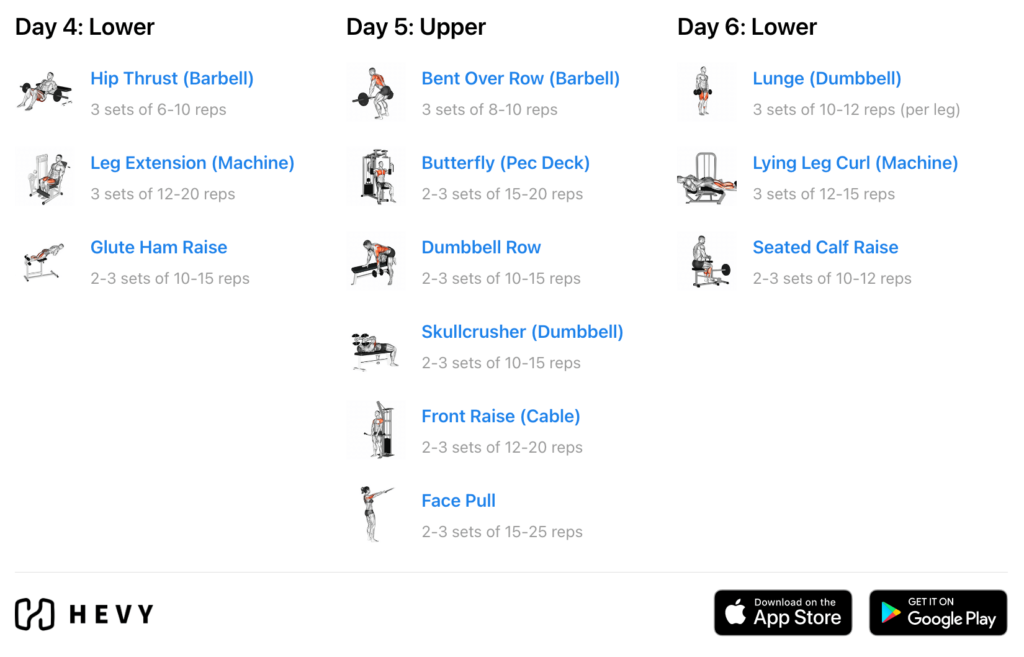

Schedule
Monday – Upper
Tuesday – Lower
Wednesday – Upper
Thursday – Lower
Friday – Upper
Saturday – Lower
Sunday – Off (Rest day)
Combining Muscles Groups for the 6 Day Split
An advantage of 6 day splits is that you can program your training in various ways and combine synergist muscle groups. One notable example is putting together the chest, shoulders, and triceps in the same workout. These three muscle groups work together on all pressing movements and develop evenly.
The back and biceps are another excellent option for pairing muscle groups. Both contribute during ‘pull’ exercises and develop well as a result. You can do a few back-specific exercises and finish your sessions with bicep isolation movements.
A push/pull/legs workout routine is by no means the only way to program your training, but it closely adheres to the rules of synergist muscle groups and makes it easy to put together good workouts.
Final Thoughts on the 6 Day Workout Split
A 6 day split is one of many training approaches people can use to build muscle, get stronger, and improve their fitness. As its name suggests, such a split is designed to have you train six times per week, offering numerous benefits. Try the Hevy App to log your workouts and keep you on track with the 6 day split.
Hevy Workout Tracker
Create your own workout splits with Hevy, and track your progress. Join +2M athletes.



For Personal Trainers
Personal trainer software to build workout programs for your clients, and track their progress.



One notable benefit of 6 day splits is that you can spread your weekly training across more sessions, making each less challenging. Doing so is also beneficial for performing better on each set and keeping muscle soreness at bay. A 6 day split is also great for gaining momentum and making regular training a part of your everyday life.
But, just as the split offers benefits, it also has drawbacks. One notable example is that committing to six weekly workouts can be physically and mentally draining, especially for people who aren’t used to structured training. Recovery days are necessary for your body to repair the training-related damage and adapt positively.
A 6 day split is best suited for younger athletes with plenty of training experience. Training daily can make it challenging to recover, so eating enough calories, getting your daily protein, sleeping well, and managing stress is essential. Still, you should always listen to your body and adjust if you notice that you’re running into recovery issues.
Six-day splits are excellent because they provide enough opportunities to train all major muscle groups and accumulate volume (sets and reps) for optimal hypertrophy and strength gain. Plus, workouts feel less demanding, making it somewhat easier to recover for each new session.




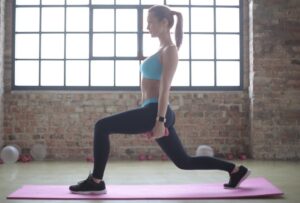
2 thoughts on “6 Day Split Workout – The Complete Guide (2024)”
Aaaah! What an article!
Hi iwant a beginner 6days …push pull legs alternative days and a mix of more flexibility strength on other days
Mon-legs plus another muscle group
Tue mixed flexibility plus strength
Wed-push
Thurs-mix
Fri-pull
Sat-mix
What all exercises i should add as it’s twice a week i am gonna hit muscles groups is it good to do all different exercises